I have written about John Dee several times in the past but always in reaction to someone making stupid statements about him so I thought that today on his birthday, he was born 13 June?July 1527, I would write something positive without prior provocation.
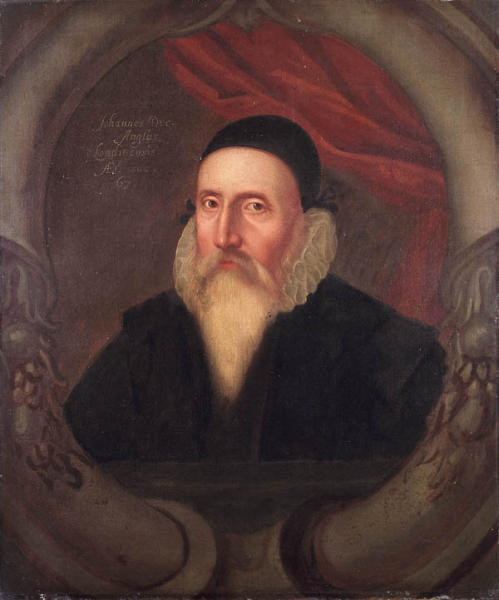
The world into which Dee was born was one in which mathematics did not play a very significant role and this was particularly true of England, which in this sense lagged severely behind the continent. During the High Middle Ages the European universities virtually ignored mathematics although the introductory degree was theoretically based on the seven liberal arts including the quadrivium consisting of arithmetic, geometry, music (theory of proportions) and astronomy. These subjects were only treated in a very superficial manner and there were no dedicated chairs for the study of mathematics.
This situation began to change in the fifteenth century at the humanist universities of Northern Italy, which introduced dedicated chairs for mathematical studies driven by the fashion for astrological medicine. To study astrology one needed astronomy, which in turn required arithmetic and geometry so the fashion for astrological medicine required a thorough grounding in mathematics. This trend spread northwards with two chairs for mathematical studies being established at the University of Krakow by the middle of the fifteenth century, one for astrology and one for astronomy. Germany?s first chair for mathematical studies was established in Ingolstadt about 1470 from whence further chairs were established, for example in T?bingen in 1507. In T?bingen Philipp Melanchthon studied mathematics and astrology under Johannes St?ffler, a graduate of Ingolstadt and developed a fable for astrology.
When Melanchthon took over responsibility for establishing the education system in the new Lutheran parts of Germany and Scandinavia, starting in 1525, he introduced chairs for mathematical studies in all the schools and universities to further his own interest in astrology. Filling the positions thus created with his own, often excellent, mathematical prot?g?s. Although individual Catholic universities such as Vienna and Ingolstadt had chairs for mathematics, the Catholic education system as a whole had to wait until the last quarter of the sixteenth century before Christoph Clavius established a comprehensive system of mathematical studies at Catholic schools and universities similar to that established for the Lutheran ones by Melanchthon. Whilst this was all going on England slept.
At the beginning of the sixteenth century England was a mathematical desert. There were no dedicated chairs for mathematical studies at Oxford or Cambridge and mathematics was not taught at all in the schools. Whereas the city of N?rnberg in the first quarter of the century could boast a whole group of excellent instrument and globe makers selling their wares throughout Europe. Henry VIII?s court had only one, Nicolaus Kratzer, an import from Southern Germany, as was the man who painted his portrait, his friend, Hans Holbein.
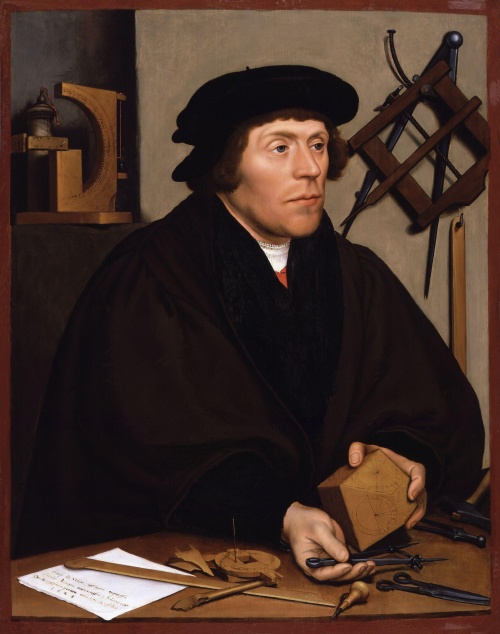
Nicholas_Kratzer_by_Hans_Holbein_the_Younger
Unfortunately the upheavals of the reigns of Edward and Mary did nothing to improve this situation and it is first under Elizabeth that things began to improve but even here the first commercial instrument maker in London, Thomas Gemini, a pupil of Gemma Frisius, was an import from the Netherlands. There were some dedicated lectureships for basic mathematics at some of the Oxbridge colleges but nothing to compare with the continental provisions. Anybody who wanted a serious mathematical education had to go to the continents, as did, for example, Henry Savile, who established the Savilian Chairs for Geometry and Astronomy to Oxford in 1619, shortly before his death, the first university chairs for mathematical studies in England.
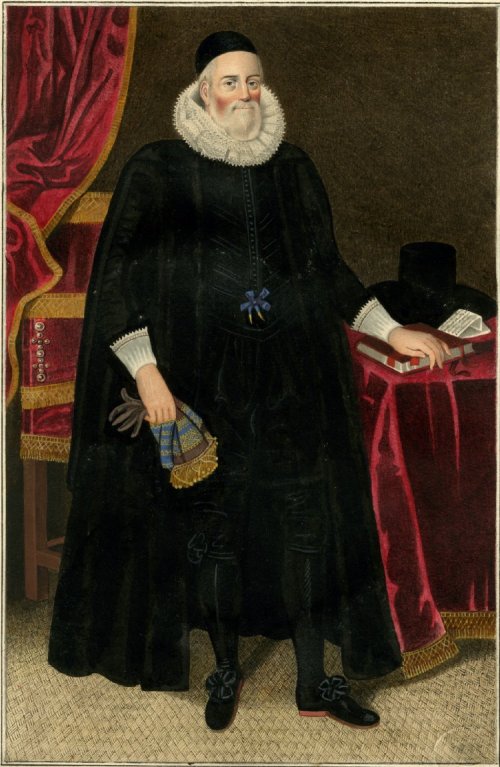
Sir_Henry_Savile_by_Sylvester_Harding
In the second half of the sixteenth century it became increasingly obvious that mathematics was becoming more and more important and as there was no initiative coming from either the Royal Court or the Oxbridge universities a group of mathematical scholars took things into their own hands and began to promote mathematical learning. This group has been dubbed by historians of mathematics the English School of Mathematics. It should be pointed out that this is not a school in any formal sense by rather an informal group of scholars spread over several generations who shared a common interest in promoting the mathematical sciences outside of the system, so to speak, and did so largely in the vernacular, the English referring to the language used rather than the nationality of those involved. This school in considered to have begun with Robert Recorde and John Dee and to have ended around the time of Isaac Newton?s rise to fame. Newton?s older contemporary John Wallis being considered a member.
The principle members of the initial group, Robert Recorde, Leonard Digges and John Dee, were all self-taught mathematicians, although Dee like Savile travelled and studied on the continent to deepen his mathematical knowledge. Dee studied under Frisius and Mercator in Leuven but also travelled extensively throughout Europe meeting and working with as well as learning from other leading continental mathematicians such as Federico Commandio in Italy.
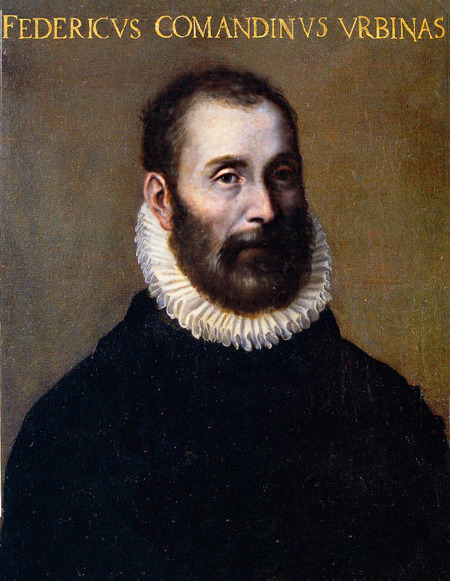
Federico_Commandino artist not known
Recorde set the ball rolling with a set of mathematical textbooks written in English covering introductory courses in arithmetic, geometry and astronomy. The last his Castle of Knowledge, published in 1556, even including a fairly positive reference to Copernican heliocentric astronomy.
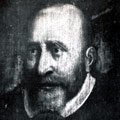
Robert_Recorde artist unknown
Recorde died in 1558 and subsequent improved editions of his books were edited and published by Dee. Dee also brought up and taught mathematics to Leonard Digges? son, Thomas, another prominent member of the School, following Leonard?s untimely demise. I will save a full history of the school for another post but wish to close with Dee?s ?Mathematicall Praeface?.
One of the important early products of the English School was the first English translation of the Elements of Euclid. This translation was carried out by The Lord Mayor of London Sir Henry Billingsley and not from a Latin translation but direct from the Greek. Published in 1570 this mathematical milestone contained a preface as well as copious notes and supplementary material from John Dee and this preface is considered to be one of Dee?s most important mathematical works.
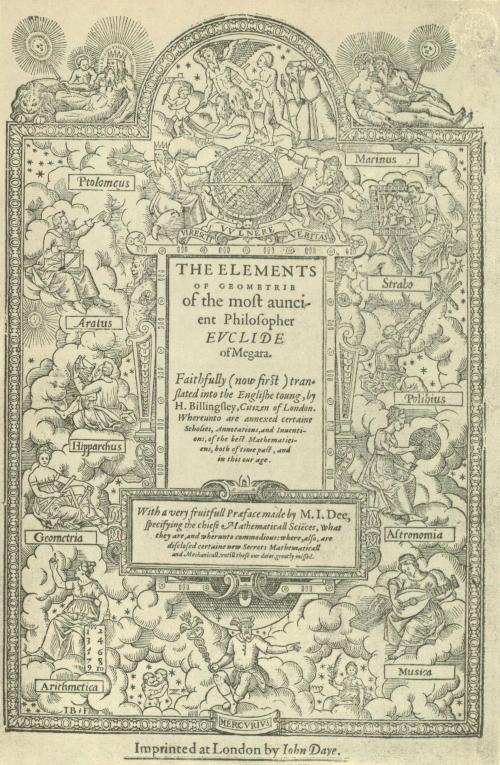
Title page of Sir Henry Billingsley?s first English version of Euclid?s Elements
In this period where mathematics was still regarded with suspicion, disregard and even with some disdain by many of the educated it was common practice for authors of mathematical texts to preface their works with some form of justification for their efforts stressing the utility of their subject. Dee?s ?Mathematicall Praeface? to the Billingsley Euclid is of this genre but it is an entirely different beast. Whereas the other mathematical authors might defend their products with a few well chose paragraphs or even a couple of pages on the usefulness of their exercises Dee?s work is a book length essay on the philosophy of mathematics.
In this work, which is a masterpiece of erudition, Dee sets out the whole range of the Renaissance mathematical sciences as Stephan Johnston an expert on the subject put it:
Dee enumerated and described an extraordinarily long list of arts, drawing on the riches of his library to present a digested treasury of Renaissance mathematics. Nor was Dee content with mere compilation; he sought to extend the mathematical pantheon, coining his own neologisms to identify topics and raise them to the status of independent arts. However, this intellectually imperialist expansion was not just an anarchic proliferation; in the ?groundplat? which diagrammatically summarised his discourse, Dee gave a powerfully graphic demonstration of the hierarchy and structure of the mathematical arts and their dependence on geometry and arithmetic as twin foundations[1].
Dee?s ?Mathematicall Praeface? is one of the finest products of Renaissance mathematics and enjoyed a very good reputation throughout the seventeenth century fading into obscurity as Dee the Renaissance magus came to replace Dee the Renaissance mathematicus in the popular imagination. It is however a work that deserves to be better known than it is and for any brave souls who prepared to do battle with the fruits of Renaissance mathematics there is a modern annotated edition available by Allen Debus.[2]
[1] Stephen Johnston, The identity of the mathematical practitioners in 16th-century England.
[2] John Dee, The mathematicall praeface to the Elements of geometry of Euclid of Megara (1570), with introduction by Allen Debus, New York, History of Science Publications, 1975
Like this:
Loading...
MAC Cosmetics The Voice Results Miss USA 2013 Daytime Emmy Awards 2013 Danielle Bradbery kate spade danny green
No comments:
Post a Comment
Note: Only a member of this blog may post a comment.